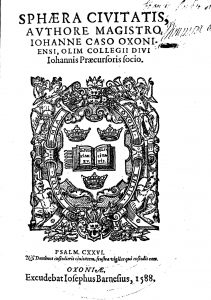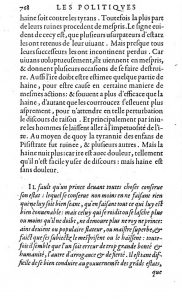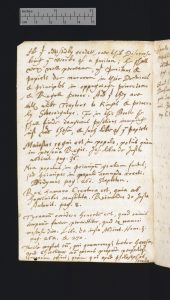I say then … that peoples are not created for their magistrates, but, to the contrary, the magistrates for their peoples, just as the teacher for the pupil, not the pupil for the teacher, and the shepherd for the flock, not the flock for the shepherd [Ie di donc … que les peuples ne sont creez pour les magistrats: mais au contraire les magistrats pour les peuples: comme le tuteur est pour le pupille, & non le pupille pour le tuteur, & le bergeur pour le troupeau, & non le troupeau pour le bergeur].
Theodore Bèze (attrib.), Du Droit des Magistrats (n.p.: 1574), 9-10
GUISE. What glory is there in a common good, / That hangs for every peasant to achieve?’
Christopher Marlowe, The Massacre at Paris (1593), ii.97-8
One of the project’s research objectives is exploring how Marlowe’s works reflected, and contributed to, contemporary conceptions of the political community.
This field is a good example of how research questions evolve and change over time. Initially I envisaged a focused analysis of the relationship between Marlowe’s work and ‘resistance’ theories (arguments justifying armed resistance to rulers). It increasingly seemed that the richest way to link such material to Marlowe was through the larger questions about the nature of the political community, and its priorities, which it raised.
On this page you’ll find some examples of the project’s research in this area. There’s also a video, above, which considers Marlowe’s relationship to resistance theory.
1.The importance of Aristotle
The Greek philosopher Aristotle underpinned a great deal of thinking about the political community in Marlowe’s day. His Politics and Ethics, in Greek or Latin translation, were staple reading for University students. Marlowe would have known them well. Aristotle’s theory of the polis, or city, were also important for ideas of the church or Christian community among both Protestants and Catholics. Even those who sought to challenge Aristotle, like Jean Bodin, were indebted to his ideas and analytical approach.
There were different ways to read Aristotle in Marlowe’s period. The Sphaera Civitatis of the Oxford don John Case (1585) offers one route: its faintly scholastic format, a series of quaestiones (‘questions’ or debates) raised by the Politics, is clearly related to the way Aristotle’s text was taught at Oxford. The French translation of the Politics, with commentary, by Louis Le Roy, first published in 1568, offered a more humanist model. Le Roy links Aristotle’s ideas to ancient and more recent thinkers, including Machiavelli, and offers much contemporary political comment, not least in the remarkable Preface to Book V (abandoned in later editions) in which Le Roy exhorts his countrymen to cease their destructive civil wars. Le Roy’s translation was extremely popular in England and remains a masterpiece of Renaissance prose.
2.Publishing and Reading the Vindiciae Contra Tyrannos
The Vengeance Upon Tyrants was the most sophisticated of the radical Calvinist tracts published after the St. Bartholomew’s Day Massacre of 1572, in which French Catholics, abetted by the monarchy, killed their Protestant compatriots. It argued that tyrants injuring the common wealth could legitimately be resisted and indeed, in certain circumstances, killed.
English printers were wary of publishing resistance doctrine. In 1588, however, the printer-publisher John Wolfe obtained a license to publish the fourth quaestio (‘debate’) of the Vengeance in an English translation by ‘H.P.’ This section of the famous tract deals only with the rights and obligations of princes, not subjects, however. A marginal comment added to the translation makes clear its opposition to the arguments canvassed in other (not translated) sections of the Vengeance, as the image below shows.
The Vengeance was probably not as widely read as other ‘resistance’ tracts of the time, such as the expanded edition of Le Reveille-Matin (1574), which was also published simultaneously in Latin, and the De Iure Regni Apud Scotos of George Buchanan (first ed. 1579). Nonetheless it was read. The Cambridge don Gabriel Harvey owned a copy. In 1605, more than a decade after Marlowe’s death, Francis Meres bought a copy of the original 1579 edition (Cambridge University Library, shelfmark Peterborough F.5.13). Meres, who is now known chiefly for his Palladis Tamia (1598) – it mentions Shakespeare – had just become Rector of a small village in Rutland. His plentiful annotations to the Vengeance are hostile. He thought it the work of a ‘Puritane’ – Puritans in his view being, like Catholic opponents of Protestant England, ‘Traytours to Kings and princely Soveraignety’.
Francis Meres’ copy of the first, 1579 edition of the Vindiciae Contra Tyrannos [Cambridge University Library, Peterborough F.5.13], front flyleaf. Image published with the permission of Cambridge University Library.
3.William Charke reads the de Justa Abdicatione Henrici Tertii
In the late 1580s, Catholic opponents of the French king Henri III sought to justify the notion that a tyrant could be attacked or killed on behalf of the political community. One of the most notorious of these tracts was On the Just Deposition of Henry III, probably written by the radical Parisian cleric Jean Boucher. A Latin work, it came out just after Henri’s actual assassination by a Jacobin friar, Jacques Clement (a scene dramatised in Marlowe’s The Massacre at Paris).
In 1592 an Englishman, William Charke, acquired the second edition of this tract (Bodleian Library, shelfmark H 8 4o Art. Seld). His comments on its title page register a profound (but perhaps also deliberately performed) horror at its doctrines: ‘a mirror of Catholic tyranny and perfidy [speculum Romanae tyrannidis & perfidiae]’, he writes. Charke was a prominent Puritan and therefore a target for the Anglican establishment. Within a few months of purchasing De Justa, he had lost his lectureship at Lincoln’s Inn, on the direct orders of the Archbishop of Canterbury.
Title page of William Charke’s copy of Jean Boucher’s De Iusta Henrici Tertii Abdicatione (1591) [Bodleian 8 H 40 Art.Seld]. Reproduced with permission of the Bodleian Library, Oxford.
4.Lord Burghley and the exile of Gaveston.
Early in Marlowe’s play Edward II the English nobility and clergy force the king, in an emotionally fraught scene [I.iv.1-93], to exile his favourite Piers Gaveston – an action based on historical fact. The justifications they offer for coercing a monarch are connected to contemporary theories of the political community.
The implications of the king’s unwilling consent on this occasion interested others in England beside Marlowe. Among William Cecil, Lord Burghley’s papers in the British Library, are brief notes, mostly in French, discussing Gaveston’s exile (MS Lansdowne 22, fols. 221r-v). They argue that a monarch’s person (‘personne du roy’) could not invalidate decisions carried out on behalf of the crown (‘raison du couronne’), and imply that a subject should obey the latter rather than the former.
It is unclear why Burghley wanted an opinion, if indeed he wanted it. Nonetheless, historians of Elizabethan England will know of a number of occasions, and one in particular, where such a view (and precedent) might have been useful for Elizabeth’s chief minister to have.
The project ran some workshops on the subject of the common good and the community, based on a scene in The Jew of Malta. Click here to find out more.



